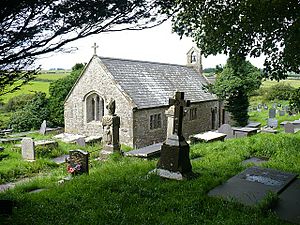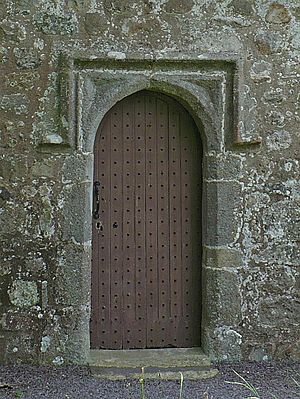St Cwyllog's Church, Llangwyllog facts for kids
Quick facts for kids St Cwyllog's Church, Llangwyllog |
|
|---|---|

St Cwyllog's Church from the north-west, showing the annexe to the main church
|
|
| Lua error in Module:Location_map at line 420: attempt to index field 'wikibase' (a nil value). | |
| OS grid reference | SH 434 796 |
| Location | Llangwyllog, Anglesey |
| Country | Wales, United Kingdom |
| Denomination | Church in Wales |
| History | |
| Status | Church |
| Founded | 6th century; earliest parts of the present building may be from c.1200 |
| Founder(s) | St Cwyllog |
| Dedication | St Cwyllog |
| Architecture | |
| Functional status | Active |
| Heritage designation | Grade II* |
| Designated | 12 May 1970 |
| Style | Medieval |
| Specifications | |
| Length | 45 ft 6 in (13.9 m) |
| Width | 15 ft 3 in (4.6 m) |
| Other dimensions | Annexe at west end: 20 ft 6 in by 15 ft 6 in (6.25 by 4.72 m) |
| Materials | Rubble masonry and quoins |
| Administration | |
| Parish | Llandrygarn with Bodwrog with Heneglwys with Trewalchmai with Llannerch-y-medd |
| Deanery | Malltraeth |
| Archdeaconry | Bangor |
| Diocese | Diocese of Bangor |
| Province | Province of Wales |
St Cwyllog's Church in Llangwyllog, Anglesey, North Wales, is a very old church with a rich history. It was first started by a saint named Cwyllog way back in the 6th century. While we don't know the exact year, parts of the building you see today might be from around the year 1200!
This church has some special features, like an unusual annex that was added in the 16th century. It also has unique 18th-century items inside, including a rare "three-decker" pulpit and reading desk from the Georgian period.
St Cwyllog's Church is still used for worship today by the Church in Wales. It's considered a very important building and is protected as a Grade II* listed building. This means it's a "particularly important building of more than special interest" because it's a great example of a medieval church with interesting features from different centuries.
Contents
History and Location
St Cwyllog's Church is located in a quiet, countryside area in the middle of Anglesey. It's about 3 miles (5 km) northwest of Llangefni, which is the main town in the area. The nearby small village of Llangwyllog actually gets its name from the church! The Welsh word llan means "church," and "–gwyllog" is a form of the saint's name.
Who Was St Cwyllog?
The first church on this spot was founded by Cwyllog, a female saint, in the 6th century. She was one of the daughters of St Caw, a king from northern Britain. When St Caw lost his lands, he and his family found safety in Anglesey. The ruler there, Maelgwn Gwynedd, gave them land.
How Old Is the Church Building?
Records show that a church existed here by 1254. Some of the walls of the current building might even date back to around 1200. In the 13th century, the church was connected to the priory at Penmon, on the east side of Anglesey.
The north doorway and the east window of the church were added in the late 15th century. An extra section, called an annexe, was built at the west end of the church in the second half of the 16th century. Some repair work was done in 1812, and more improvements happened in 1854.
The Church Today
St Cwyllog's is still an active church and is part of the Church in Wales. It's one of seven churches in a group of parishes. The church is part of the Diocese of Bangor.
Architecture and Special Features
The church is built from rough stone blocks, with larger, carefully shaped stones at the corners. The roof is made of slate. The main part of the church is about 45 feet 6 inches (13.87 meters) long and 15 feet 3 inches (4.65 meters) wide.
The Annexe and Bell
The annexe at the west end is smaller and lower than the main building. It was built in line with the church and might have been used as a schoolroom. It has a doorway from the 16th century, which was turned into a window later. There's also an 18th-century fireplace inside.
At the west end of the roof, there's a small tower called a bellcote with a single bell. This bell is decorated with three bull heads and is dated 1661. The main entrance to the church is on the north side, and it dates from the late 15th century.
Windows and Inside Details
The east window in the main part of the church is from the 15th century. It has three sections with a pointed arch. Beautiful stained glass by the artist Henry Holiday was added in 1882. The windows on the north wall are from the late 16th century.
The church has a round stone font from the 13th century. It's carved with detailed leaf designs and knot patterns, though some parts were left unfinished.
Unique 18th-Century Fittings
Many of the church's other fittings, or interior items, are from the late 18th century. St Cwyllog's was updated in 1769. These fittings include a special "triple-decker" pulpit combined with a reading desk. This type of pulpit is quite rare. It has an inscription that says "M T I I WARDENS 1769."
The altar has communion rails on three sides, likely from the same time as the pulpit. There are also old wooden seats and various memorials from the 18th century. One box pew (a private seating area) is from the 18th century, and another is from the 19th century.
Silver Chalices
St Cwyllog's has three silver chalices (cups used in church services) from the 16th century. The lid of one of these chalices, dated 1578, was returned to the church in 2010! An antiques dealer had bought it, thinking it was a Tudor sugar lid. Later, a conversation with a local clergyman helped them realize it belonged to the church, and the dealer decided to return it.
Why Is This Church Important?
St Cwyllog's Church is nationally recognized and protected. It's a Grade II* listed building, which is the second-highest level of protection. This status was given on May 12, 1970. It's listed because it's a "good rural medieval church" that still has features from the 15th century and its original simple medieval layout.
Cadw, the Welsh government body that protects Wales's historic buildings, also points out the special 18th-century fittings and memorials. They also note that having an annexe at the west end is unusual for churches in Anglesey.
Historians and experts have praised the church over the years. In the 19th century, Angharad Llwyd called it "small, but remarkably well built." Another expert, Harry Longueville Jones, said in 1859 that St Cwyllog's had "rather better architectural features about it than most of the small churches in Anglesey." More recent guides also highlight its "rare surviving Georgian fittings," like the pulpit, and describe its interior as one of the "earliest and finest" in Anglesey.



